Let's Get Started
In this digital age, staff are being swamped by information and inefficient means of managing this information. Doubled up content across multiple folders in shared drives. Information lost in long email threads. Delays in processing paper forms. The inability to access resources outside of head office. Disconnect from colleagues working in different locations. Lack of transparent and inconsistent communication from the organisation.
We all deserve better, and better can be achieved. In this guide, we explore intranet best practices to unlock internal communication, engagement and productivity for your organisation.
Intranets can be the key to staff engagement, workplace culture and at the heart of it – getting things done
What are the key intranet best practice tips?
- Understand the intranet essentials
- Recognise why intranets fail
- Develop your intranet strategy
- Consider intranet design and user experience
- Find the right platform
- Tie to back to productivity, engagement and culture
Want Us to Email You a Copy to Read Later?
No problem! Just enter your details below, so we can send it to you.
So how do you create an intranet that will be used to its full potential?
Let’s start by breaking down exactly what an intranet does, and then move onto the best practices for implementing the right system and structure.
Chapter 01
Understanding the Intranet Essentials
First things first: what is an intranet?
At its simplest definition, an intranet is a private enterprise network designed to support information sharing, communication and collaboration within an organisation. This network can be hosted in the cloud, on-premises or externally.
But if we look closer, an intranet is far more than a simple network.
An intranet forms the foundation of your digital workplace, and plays an important role in improving how employees interact, learn, engage, share information, work together and achieve the objectives of your organisation.
The advantages of an effective intranet can become clear soon after it’s launched. You can expect:
- Easier and faster access to useful information
- Streamlined processes, such as forms and workflow automation, onboarding and document management
- Improved and personalised communication between organisations and staff
- Self-service access to resources at any time, on any device
- Increased collaboration between staff, particularly those who work in different locations
- Better employee engagement and culture, and
- Higher employee productivity.
The benefits of intranets are so far reaching that intranets are used in healthcare, finance, professional services, legal, governments, not-for-profits, schools, education institutions, construction, manufacturing, logistics, automotive and transport, healthcare, retail, utilities, mining, energy and more!
"Nula has enabled staff to search for information, policies and people, and find them easily. These basic needs are difficult to meet in an organisation of our size and geographical dispersion. Elcom were attentive, friendly, helpful and responsive along the Nula journey, thank you!"
Madeleine Donkin, Digital Business Development Manager, Northcott
Pretty powerful stuff.
So how does one system produce so many benefits?
Through the various features and uses of an intranet.
An intranet can be a complex system with diverse functionality that can benefit your workplace – so let’s write a shopping list.
At its most basic, your intranet should:
- Provide a central, secure repository for information.
- Allow users to quickly and easily search for relevant data.
- Enable communication on an individual, project-based and organisation-wide level.
- Streamline the creation of online forms and automated workflows for form approval.
- Support event sharing, management and planning with calendar functionality.
- Provide a corporate directory where a user can find contact details.
- Share important objectives, motivation and encouragement.
- Support eLearning if required, for staff training and professional development.
This list can be expanded even further with additional built-in features of a good intranet platform, as well as with integration and customisation.
Today's successful organisations use an intranet to form the foundation of their digital workplace.
What is a digital workplace?
A digital workplace is a virtual ecosystem, encompassing all the digital tools that an organisation uses in their day-to-day operations. This ecosystem is unique to each organisation and its industry.
How does an intranet fit into a digital workplace?
Your digital workplace might already rely on any number of third-party platforms and employee productivity tools, including Microsoft Office, Salesforce, Google Drive, Amazon AWS, SharePoint, Active Directory and others.
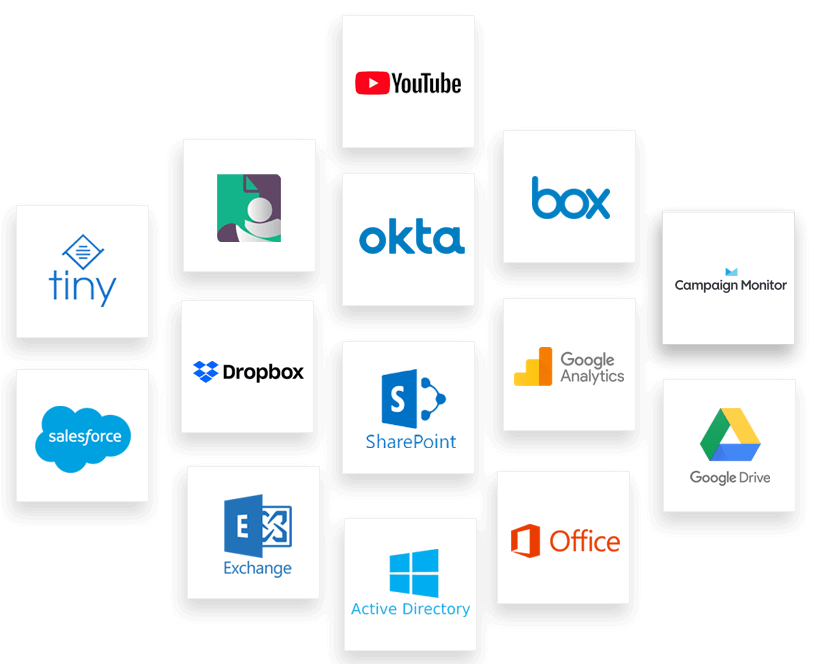
In an effective digital workplace, the core intranet is the first point of call to external platforms that enables comprehensive access to all relevant data and tools. This can happen in a number of ways.
-
Quick links
An intranet can provide quick links to other systems, with or without single sign-on capabilities, which means staff can log into the intranet and once they click through to the other platform, they’re automatically logged in. Star Group, for example, takes this further by personalising the quick links shown depending on the staff member's role. This means they don’t need to remember how to access the other platform or remember another password.
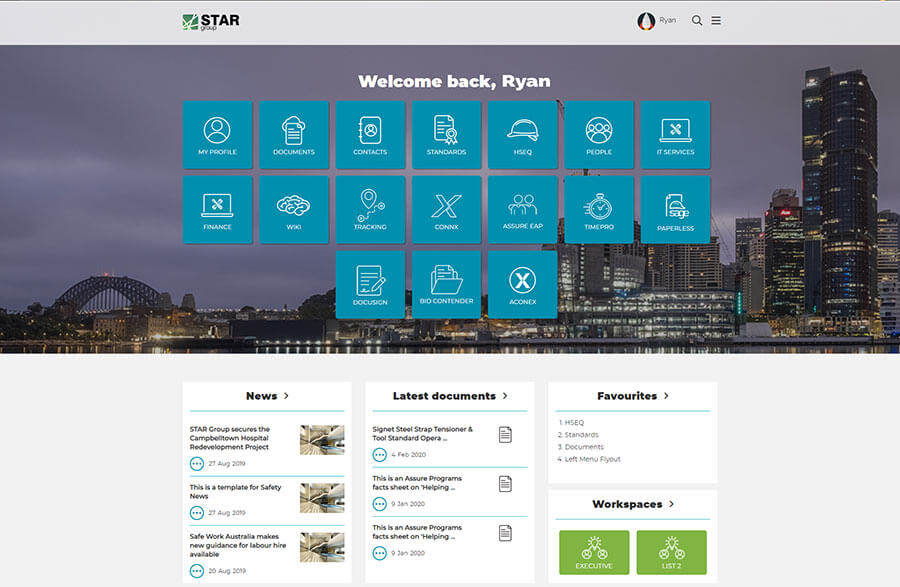
-
One way integration
An intranet can integrate one way with these systems to dynamically pull in snippets of information, turning the intranet into a central hub of information. For example, Taking Shape pulls through the weekly and monthly earnings for the store the staff member works in onto a graphic sales performance dashboard. These figures are updated automatically 3 times a day.
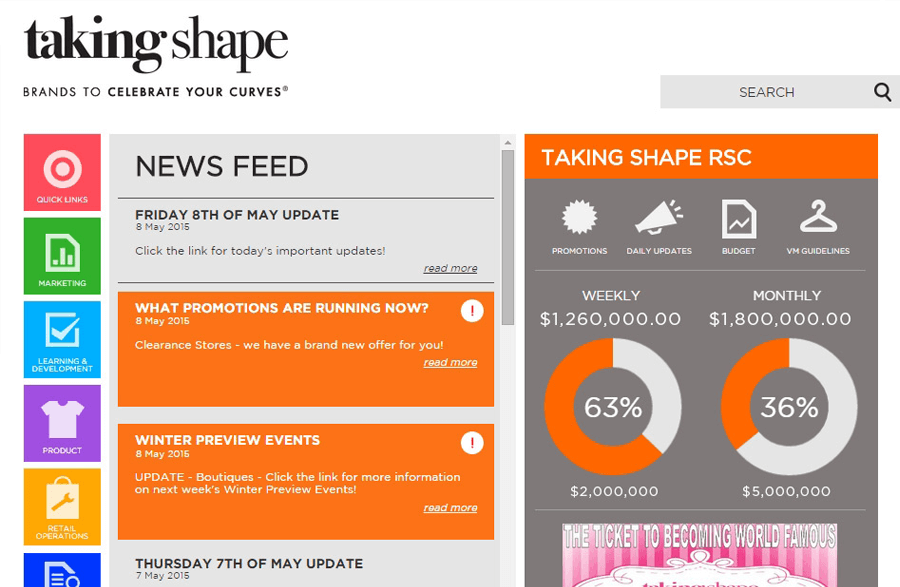
-
Two way integration
An intranet can integrate two ways to both pull in information and update information in the external platform. For example, the Ascham School Hub is the central information and communication platform for parents of students at the school. The Hub integrates with their school information management system, Synergetic, so parents can view their children’s medical information within the Hub. If they update any details here, it goes through a workflow and once approved, is updated in Synergetic. This saves everyone from having to jump between platforms.
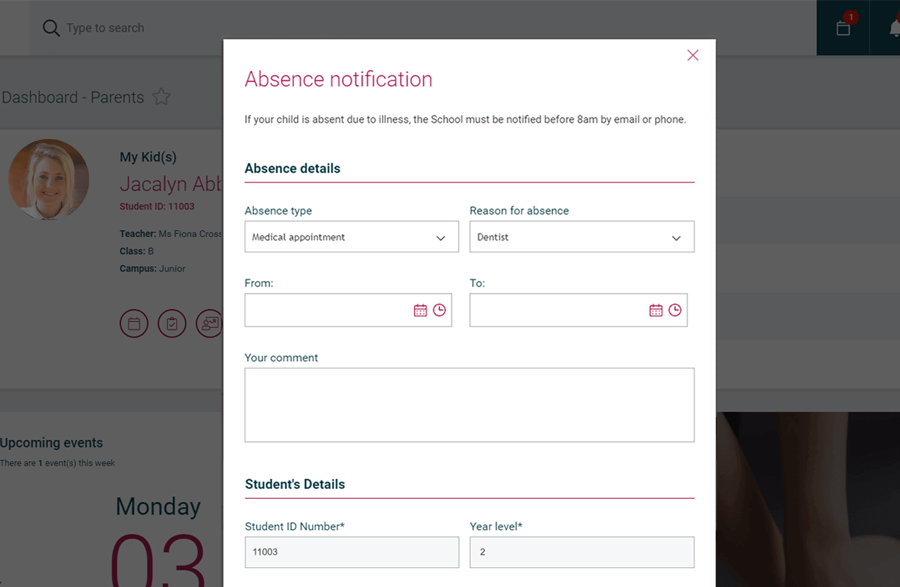
In its essence, an effective digital workplace makes the complex simple.
If we could actually see the current digital work world encircling us, it would leave us breathless, given its reach, depth and moving parts; it would be not just a new continent but a new planet (only digital).”
― Paul Miller, The Digital Workplace: How Technology is Liberating Work
So how do you ensure you’re building a successful intranet and digital workplace?
To learn what to do, let’s first learn what not to do.
Chapter 02
Avoiding the Tumbleweeds: Why Intranets Fail
Far too many intranets end up like a ghost town, with lonely tumbleweeds blowing down the main street. Here are the most common reasons that intranets fail:

The intranet interface and architecture is about as clear as mud. |

Finding the right and accurate version of required information is a nightmare. |

There’s a set and forget mentality, so the intranet becomes a content dumping ground. |

There’s no sheriff in town and no one owns up to or manages the content. |

It’s an unruly repository of communication and information that’s irrelevant to the user. |

Nobody has a clue about how the system should actually be used – or what its purpose is. |
If any of these seem relatable, then it’s time to improve or implement a new solution.
To maximise usability and build an intranet that functions as a thriving hub of information and communication, it's worth keeping these intranet best practices in mind as you go:
- Create a compelling business case, ensuring everyone understands the need for an intranet.
- Plan for the end user, thinking through the design, function and content needed to improve adoption rates.
- Follow a well-thought out intranet plan, consulting with employees to identify core requirements.
- Make the purpose and value clear, by mapping your intranet to your business requirements.
- Create an administration hierarchy, so you can determine roles and access within teams.
- Think about mobility, particularly for those working in the field, remotely or in the workshop.
- Understand design needs, ensuring content is accessible on smaller devices.
- Develop a launch plan, with launch ideas to increase engagement and adoption.
- Get leadership on board, through active intranet promotion and participation.
- Create a governance plan, detailing everything from who owns what section, to the process for updating content.
Building a successful intranet
Given the large technology stack your organisation already has, ask yourself: what incentive do staff have to use the intranet? Putting in thought into planning your intranet project is key. Make sure you dig deep into what pain points your intranet needs to address, get leadership on board and put in place a clear governance plan to keep content relevant.
Chapter 03
How to Develop Your Intranet Strategy
You know the old chestnut – those who fail to plan, plan to fail.
If you’re implementing a new intranet for your organisation or replacing an existing system, it’s vital to develop an intranet plan or strategy to ensure your new system will address every important requirement.
Tip: An intranet CMS provider can help you navigate throughout the entire project lifecycle, from scoping and design to support.
Where does planning begin?
To build your intranet plan, you’ll want to:
- Define your goals and purpose.
Let’s clarify all of your goals, and let’s be SMART about it. For example, ‘we want to reduce emails sent internally by 25% after three months of launching our intranet’.
- Identify your end user personas.
How can we segment the audience for an intranet, and what are their pain points, needs, behaviours and technology preferences?
- Establish governance.
Time to decide who will maintain the policies and decisions of your intranet, to ensure it runs like a well-oiled machine. Here’s how to ace this step.
- Choose your intranet team.
Avengers, assemble! Here’s where you nominate your intranet’s project manager, user representatives you can consult with, and your intranet administrator/s.
- Choose your intranet features.
The next step is to outline and prioritise the intranet features that will have the greatest impact for your organisation: document management, enterprise search, dynamic widgets, and the list goes on
From here you can begin to build your intranet architecture, setting out data in a logical hierarchy that will make it easy for employees to locate and interact with the content they need access to.
How should information be structured?
This depends. This should be reflective of the insights you've gathered from your staff. Since they will be the end users, they should have the biggest influence over how navigation is structured. Aim to learn what the common terms and their specific needs from the intranet are. And remember, with personalisation, you can display different navigation menus to different groups of people.
Depending on your organisation’s structure, it might mean that data is best separated into departments, projects, functions or services, or a combination of these.
It can also be organised by task, which will help to avoid the issue of restructuring your intranet if your organisation happens to be restructured in the future. An example of task-based organisation might include headings such as ‘Finding People’, ‘Product Finder’, Policies, Forms, Employee Benefits and so on.
With this approach, you might first make a list of typical staff tasks that can done on the intranet, then refine and group these into categories if appropriate. Then, ensure you get feedback from the staff who will be using the intranet by asking them to select the top 5 or so tasks they’d typically carry out.
3 key ways to keep information relevant to each user
- Master the navigation
Navigational tools make it simple and fast for users to find the specific information they need. This can include features like quick links, breadcrumbs, search and mega menus.
- Implement security permissions
Security permissions will keep data open to each user while restricting access to any information that might be sensitive. You can essentially deliver multiple intranets in one, with each group of users seeing a different branding scheme, navigation menu items, sections and other information. Staff can also customise their homepage by starring or favouriting features, as well as subscribing to alerts or newsfeeds about a specific task or topic.
- Get continuous feedback from staff
All aspects from the overall intranet structure down to specific terminology might make sense to you, but not all staff have the same thought processes. Your intranet project should start with research from staff (end users) and feedback should be continuously sourced and used to drive the development and beyond. Your intranet should be an evolution, not something to set and forget.
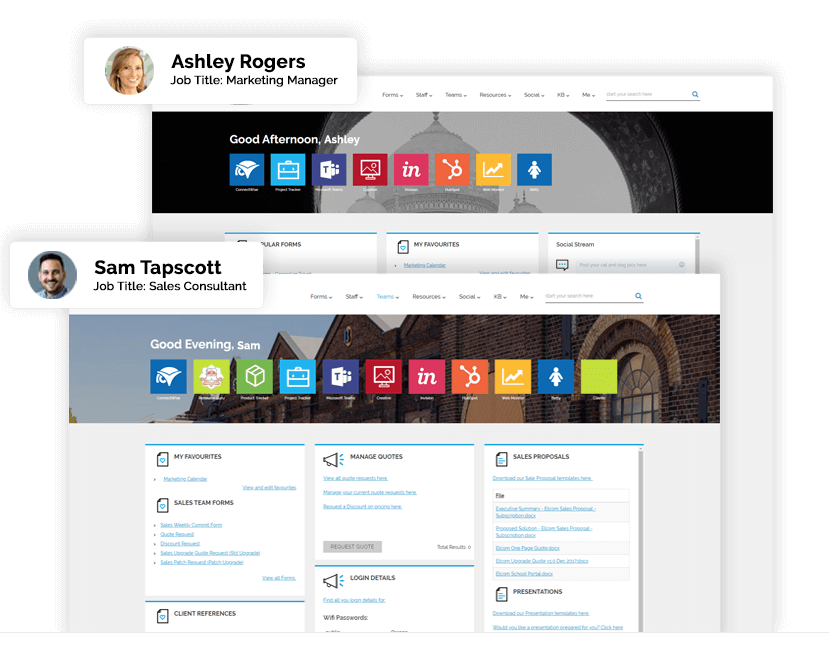
A sophisticated intranet platform enables you to present personalised dashboards and information to each user.
Case Study
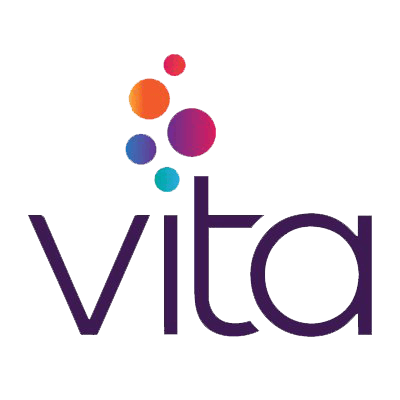 The Problem
The Problem
Vita Group's intranet had multiple issues. Since its design in 2011, user behaviour had changed considerably, the need for mobile access had increased and there was lots of double handling of information due to lack of integration.
The Solution
A new intranet was developed through careful planning, and information was structured around user behaviour data. Content and access are now personalised based on role and business area, together with live search functionality that helps team members search as they go rather than needing to navigate forward and back to refine their search.
Read more
Chapter 04
Considering Intranet Design & User Experience
What constitutes ‘good design?’
There are, thankfully, common intranet design guidelines and principles you can follow.
Ideally, your intranet design will be minimal, on brand and also responsive so it will work on any device.
A great intranet design is one you barely notice – because things simply work the way they’re supposed to.
Good design is user-centric.
Design should make sense to your end users and help them achieve their goals. Consider the top resources and core tasks the user will be accessing often, for example FAQs, news and support documents, and give these visual hierarchy over less important resources.
Good design makes searching for information easy.
You can utilise a number of search features to help users as they search. This might include Best Bets, user-targeted search and clickable search metadata. Mega menus can set information out in a clear and ordered way, though be sure not to overload the user with too many options.
Good design often involves a phased approach.
Once more, continual feedback is key in ensuring your design is right for end users. You might set up surveys or even watch team members as they navigate the intranet to see what can be improved from a design perspective, from font sizes to layout.
How does user experience come into play?
User experience, or intranet UX, relates to all the aspects of your intranet that affect how people use it.
A modern intranet enables you to easily automate many of the typically cumbersome processes within an organisation, such as creating and completing digital forms with pre-filled information, submitting and reviewing documents and gathering feedback.
Key factors of a good user experience can include everything from clear and easy-to-find menu headings, to intranet tools and workflows that are tailored to the user’s projects and goals:
- Personalisation
This includes top-down personalisation for certain departments or groups; and end user personalisation to allow users to customise their own homepage and processes.
- Search tools
This can include Boolean searches, spelling and variations and Best Bets, which each help to point the user to the required information faster.
- Navigation tools
This includes menu design and structure, page breadcrumbs and quick links.
An effective user experience incorporates tools and functionality that make sense for the organisation.
Let’s say your organisation requires a system to manage and document workplace injuries, equipment damage and other incidents. A process can be set up so as the user fills in an incident notification form, this triggers a workflow requesting approval, which upon approval generates an article for the searchable Incident Library. This can save time and improve accuracy across the board.
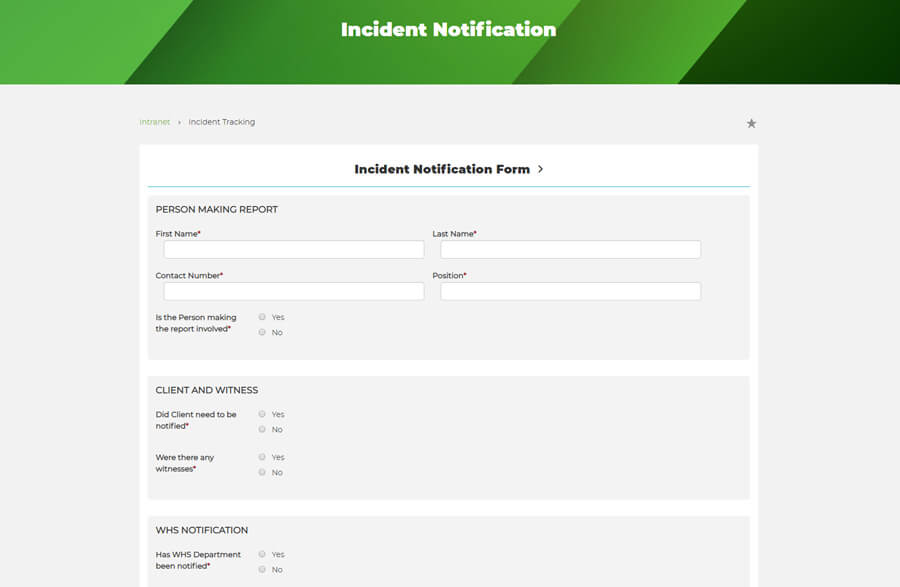
Free Resource
Want to build an intranet your staff love using, while avoiding costly intranet mistakes?
Get your free guide
In order to bring all these intranet best practices to reality, it’s going to be vital to find the right intranet platform and provider.
Chapter 05
How to Find the Right Intranet Platform
There is no one-size-fits-all intranet software, but there is a variety of intranet software designed with flexibility in mind. Find the right option for your intranet, and you’ll find that integration and customisation are far simpler and more cost-effective.
What is a content management system (CMS)?Your CMS is the platform that lets you manage your intranet. Think of it as the backend system that powers the front-facing intranet that everyone sees. It enables non-technical users to create, edit and publish content, as well as allows administrators to control access and security, and integrate third-party apps. You can find more detail on how to choose the best CMS for your needs here.
For success, ensure that your intranet CMS will tick the following boxes to be successful and valuable for your organisation:
- Functionality
Features that will align with your organisational needs, ideally out-of-the-box or capable of being built by the intranet vendor. - Integration
Integration with any third-party platforms you use, and a free API for custom integrations that can be carried out by either the intranet vendor or your in-house team. - Communication & collaboration tools
Including social updates, social Q&A, blogging and so on. - Enterprise search
Real-time search functionality to ensure employees can find information quickly and easily including Best Bets and federated search. - Design
Clean, modern and responsive design across all user and administrator intranet tools. - Security
Quality security measures including two-factor identification and security options to keep your organisation’s data safe (and compliant, if this is applicable in your industry). - Support
A supportive and reputable vendor with the expertise to help you plan and implement your new system, before, during and post intranet launch.
This final point is quite important, as you may be working closely with your vendor or provider as your new intranet is planned and deployed.
One big question at this early stage is whether you’ll also require a portal and website down the track. If so, you want to choose a CMS to build your intranet on with the capability to also build websites and portals. This simplifies site administration while also saving you time and money. You can dig further into the
lesser known CMS Features here.
- A website is your brand’s web presence – think of this as your shop front that’s open to the public.
- An intranet is the private internal network for your organisation, designed to be used by your employees and teams.
- A web portal provides access to your resources for external stakeholders. These external groups might include suppliers, clients, customers, stockists or even patients.
Although these three systems serve different purposes, they’ll often share the same information and resources. Different recipes with the same ingredients, so to speak.
It makes a lot of sense to bundle your intranet, portal and website needs into one neat web CMS solution.
By considering your enterprise CMS needs holistically instead of separately, each department and area of the business can work smoothly with each other, from sales through to accounting.
Case Study

Forty Winks wanted a new, easy-to-use and commercially proven out-of-the-box CMS to manage our intranet.
Usage of the new intranet increased 285% over the previous intranet. This is largely thanks to the personalised views of content and structure which changes depending on the group the user belongs to such as board members vs. franchisees.
Read more
How can this type of integration benefit your own organisation?
There are too many possible benefits to count (but here’s a handful)
- Automated coordination of information between sales and support teams.
- A boost to customer retention with better-informed customer service.
- Personalised marketing strategies to reach your customers, clients and/or suppliers.
- Minimised costs of maintaining one comprehensive platform instead of disparate systems.
- A clear vision for employees to see how their work matters in the grand scheme of things.
Whether you’re building an intranet or an integrated intranet, website and portal, it’s going to be essential that you choose the right platform.
How do you know if you’ve found the right provider?
Signs you’ve found an intranet provider you can rely on:
- They’re responsive to your questions and requests, including before you sign on the dotted line.
- They’ll ask to sit down with you for a detailed workshop before starting on a design.
- They can provide a high level of support, including onsite training for your team if needed.
- They’ve been in business for years and have a great track record of successful project deliverability.
- They’ve worked with other organisations in your industry and/or with similar pain points
- They provide post-project warranty to ensure your intranet meets the needs of staff.
- They provide post-project support in the form of both email and phone support, as well as an Account Manager to ensure your intranet meets future needs.
- They take security and the protection of your data very seriously, and can provide you with documentation on how they achieve this.
- Their previous projects are of a high quality, with positive testimonials from other clients.
When you might need to keep looking:
It’s wise to stay away from any provider that promises a rigid one-size-fits-all solution or a platform that requires a mass of customisation to suit your needs.
A quality intranet is one that will serve you for years to come, so look for consistency over trends.
There are only a few intranet trends worth looking for with any provider, and these will largely improve functionality:
- Decentralised content management, with ownership of maintaining and updating sections of the intranet given to different teams who produce the content, as opposed to one or two intranet publishers.
- Mobile integration, so employees can stay connected and informed from any device.
- Personalised experiences, to help people access important information quickly and easily.
- Automation and digitalisation, with organisations digitalising more of their manual and/or paper based processes to the intranet, from forms and workflows to event management and training courses.
- Metrics and analysis tools, which enable you and your teams to make informed decisions about which content to focus on and which might need more focus.
Put simply, think about what will improve the personal experience of using your intranet.
Free Resource
This guide provides a proven framework for evaluating and buying an intranet that everyone will actually use. Bonus: Detailed checklist to evaluate vendors and solutions.
Get your free guide
All of this leads us to a very important question.
You have a great user experience and an intranet that employees actually want to use.
What changes should you expect to see once your intranet is implemented?
Chapter 06
The Why: Productivity, Engagement & Culture
We’ve touched on the fact that an effective digital workspace can boost workplace culture, employee engagement and productivity, but can a new intranet service really have all that much of an impact?
As it turns out, absolutely.
Fact: Intranets can boost employee productivity
According to a McKinsey Global Institute report, the average interaction worker can spend 28% of their work week managing email and another 20% tracking down information or seeking help from colleagues.
Just think about how often you yourself might spend searching for emails in your average working day.
But what happens when you put effective internal social media technology in place?
“…A searchable record of knowledge can reduce, by as much as 35 percent, the time employees spend searching for company information.”
- The social economy: Unlocking value and productivity through social technologies
This report demonstrates that companies can raise employee productivity by 20-25% simply by implementing social technologies.
Manage internal processes well, and your productivity can skyrocket.
The trick is to find comprehensive employee productivity software that will make it fast and easy to find information: from events, to staff directories, to communication tools.
Fact: Intranets can boost employee engagement
It literally pays to have highly engaged employees in your organisation. As a Gallup Workplace study found:
“Work units in the top quartile in employee engagement outperformed bottom-quartile units by 10% on customer ratings, 22% in profitability, and 21% in productivity.”
-Susan Sorenson, How Employee Engagement Drives Growth
So – how do you keep employees committed and motivated towards your organisation and its goals?
To foster high employee engagement, the employee experience is key.
There are a number of different ways you can actively build employee engagement using your modern intranet system.
- Using social tools such as workspaces, wikis, Q&A, blogs and social updates to encourage collaboration and innovation within teams.
- Creating two-way communication channels between the C-Suite and teams that might not otherwise be possible in a large or multi-locational organisation.
- Providing a personalised dashboard that displays the user’s most relevant information, results, projects and objectives, to help them stay engaged and on track.
- Posting public recognition of a job well done on employees’ dashboards, as well as celebrating sales targets or milestones.
Tip: Don’t forget the virtual water cooler!
It’s also important to encourage social and fun interactions in the digital workplace – a little like a virtual water cooler in the office. This can be entirely tailored to your organisation – from guessing each other’s identity based on childhood photos, to celebrating birthdays, to sharing travel photos.
Fact: Intranets can foster outstanding employee culture
A great workplace culture is something that can’t be bought or ordered.
It largely depends on having the right people within your organisation. This being said, you can absolutely put the right structure in place to build a positive workplace culture.
The attributes of a good workplace culture typically include:
- Clear communication
- Effective leadership
- A sense of trust and respect
- Engagement with the organisation’s goals, and
- The chance to learn and improve.
A modern intranet can provide the communication and collaboration tools to support each of these attributes. For example:
- Using social tools to encourage clear communication at every level of the organisation.
- Demonstrating effective leadership through structured and streamlined processes.
- Instilling a sense of trust and respect through shared recognition and celebration.
- Showing clear directives on staff member’s dashboards to share the organisation’s goals.
- Using eLearning functionality to provide the chance to learn and improve on the job.
Better yet, with the rise in remote working, an intranet - with its accessible tools anywhere and on any device - can help you effectively manage your remote workforce and building a great culture for all of your staff.
In a quality intranet platform the structure for these qualities will be built right into the system, so a great workplace culture can be encouraged and sustained in the long term.
Parting Words
An intranet is no longer simply defined. What once began as a simple file sharing network in its earliest days has grown into the stable foundation for a modern organisation.
It’s the glue that holds your operations together.
Our intranets determine how well we communicate, collaborate, learn, innovate, motivate and celebrate throughout each day in our working lives, and subsequently how organisations grow.
Your intranet will shape your employee experience and have a direct impact on productivity, employee engagement and workplace culture.
If your intranet isn’t meeting these needs within your own organisation, then it’s time to begin planning.
Have questions? The team at Elcom would be happy to provide answers or to arrange a free consultation.
Let’s work together